The Patriot Hellfire M.2 480GB Review: Phison NVMe Tested
by Billy Tallis on February 10, 2017 8:30 AM ESTRandom Read Performance
The random read test requests 4kB blocks and tests queue depths ranging from 1 to 32. The queue depth is doubled every three minutes, for a total test duration of 18 minutes. The test spans the entire drive, which is filled before the test starts. The primary score we report is an average of performances at queue depths 1, 2 and 4, as client usage typically consists mostly of low queue depth operations.
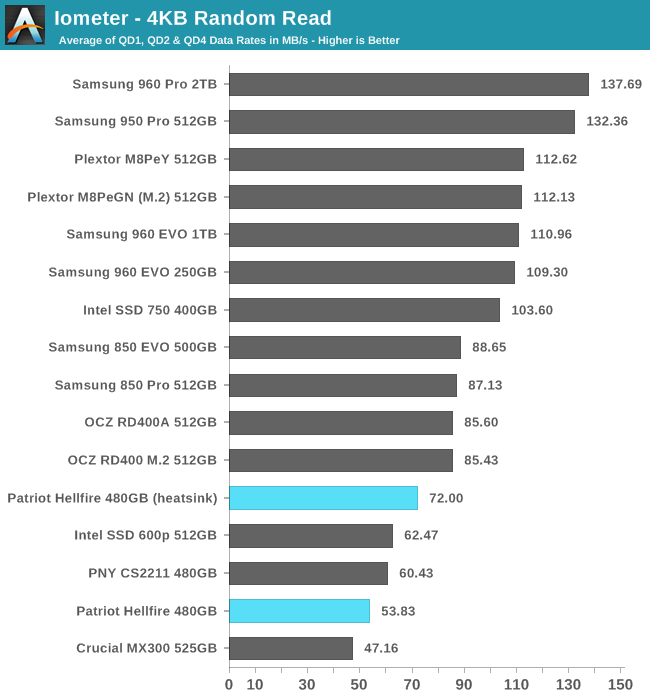
The random read performance of the Patriot Hellfire is disappointing, even when aided by a heatsink. Samsung's SATA SSDs outperform the Patriot Hellfire, and the Plextor M8Pe is twice as fast. The PNY CS2211—based on the same NAND and Phison's S10 SATA SSD controller—is the most embarrassing drive for the Hellfire to lose to.
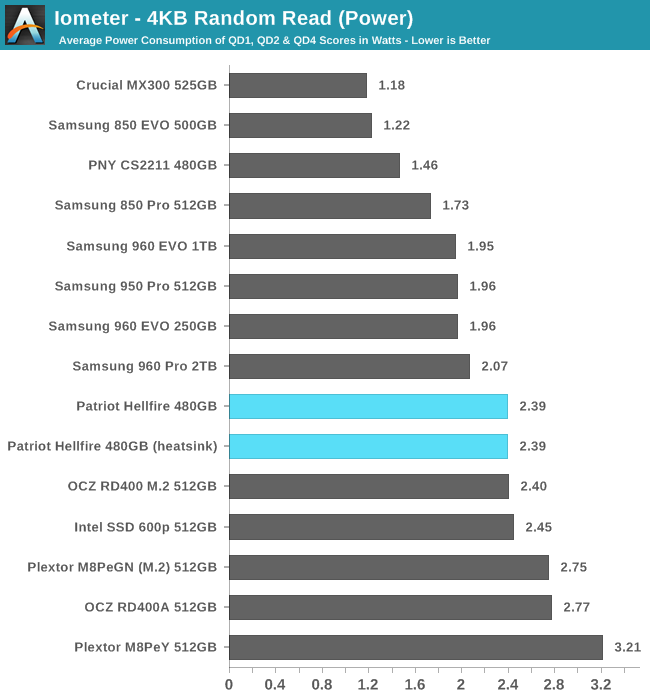
With no particular advantage in power consumption, the Patriot Hellfire gets a very poor efficiency score for random reads.
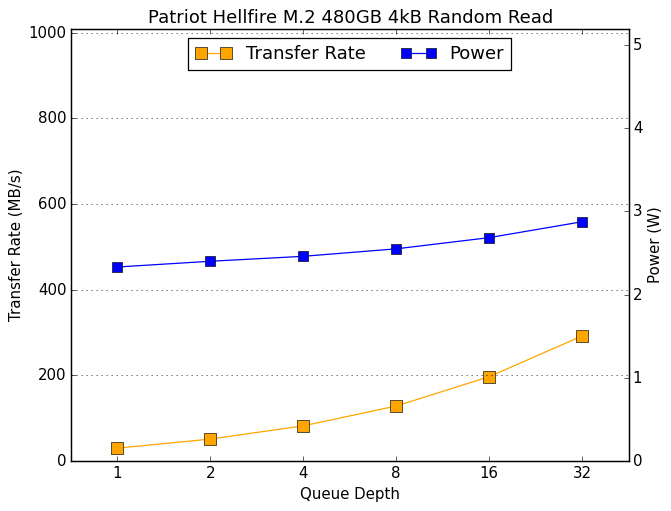 |
|||||||||
The poor random read performance at lower queue depths continues at higher queue depths, and the Patriot Hellfire cannot catch up to the Samsung 850 Pro without a heatsink.
Random Write Performance
The random write test writes 4kB blocks and tests queue depths ranging from 1 to 32. The queue depth is doubled every three minutes, for a total test duration of 18 minutes. The test is limited to a 16GB portion of the drive, and the drive is empty save for the 16GB test file. The primary score we report is an average of performances at queue depths 1, 2 and 4, as client usage typically consists mostly of low queue depth operations.
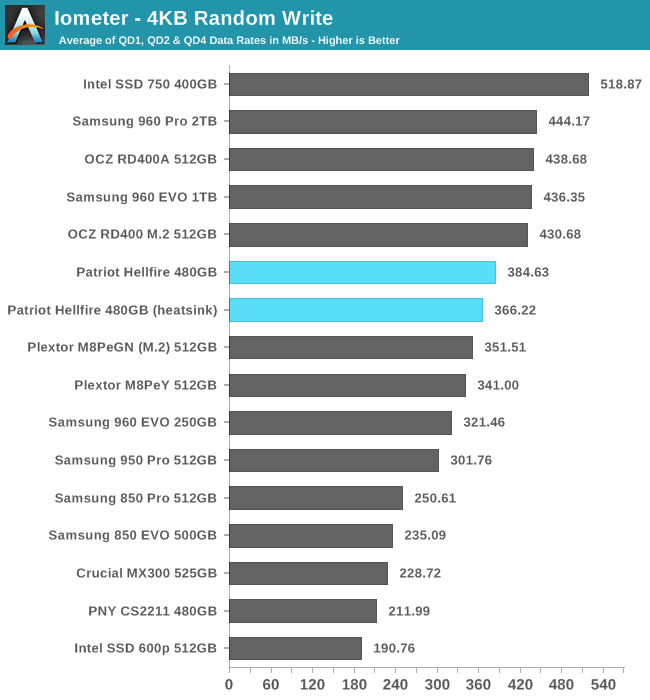
The random write performance of the Patriot Hellfire is relatively good, but it is not in the top tier. The average score with a heatsink is actually slightly lower than without, likely because the heatsink allows for higher performance early in the test, and then the drive's spare area starts to run out sooner.
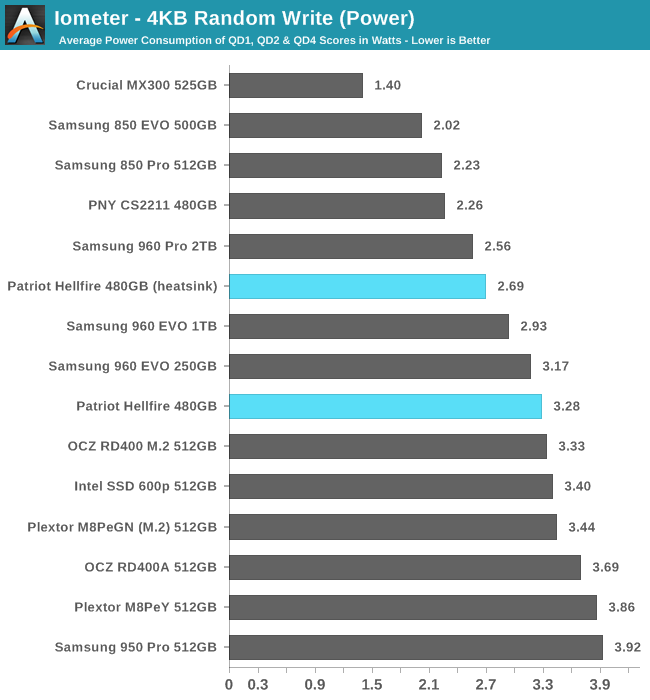
The Patriot Hellfire delivers better efficiency than most other NVMe SSDs and thanks to its good performance it is even substantially more efficient than the lower-power SATA SSDs.
 |
|||||||||
With or without a heatsink, the Patriot Hellfire's random write speed tops out at QD4 around 600MB/s. Most SSDs experience little to no improvement past this point. The Plextor M8Pe continues to slowly improve, but at QD4 its performance is sub-par.










43 Comments
View All Comments
KAlmquist - Friday, February 10, 2017 - link
"...a Phison E7 SSD might make sense at the 120 GB capacity point where Samsung has no offering..."IF the performance of the 120 GB version is close to that of the 480 GB drive. It appears that Patriot isn't sending the lower capacity drives out to reviewers. The link given below reports that the 240 GB model providing about 86% of the speed of the 480 GB model. That number may not be terribly meaningful because the reported speeds vary a lot (presumably because some drives were fuller than others when the benchmarks were run), but it seems to be the best data we have. The law of diminishing returns suggests that the performance gap between the 120 and 240 GB models will be greater than the gap between the 240 and 480 GB models. So it seems quite possible that the 120 GB model is a real dog.
http://ssd.userbenchmark.com/SpeedTest/184918/Patr...
HideOut - Friday, February 10, 2017 - link
So why is a supposedly leading tech site doing their review on Windows 8.1? There are already features and such unusable if you don't have 10Ryan Smith - Saturday, February 11, 2017 - link
We're purposely slow to switch OSes so that we can work out the kinks first. Win10 has taken a bit of time to get to place nicely with our SSD tests, though we should be ready to finally roll it out in the next couple of months.HomeworldFound - Sunday, February 12, 2017 - link
That basically means in several years when nobody is reading any more.Billy Tallis - Monday, February 13, 2017 - link
After this review, I have two engineering samples and one retail drive that I'll be reviewing with the 2015 test suite, and then I'll be switching over to the 2017 test suite using Windows 10. If all goes well and if I get enough of the back catalog of drives re-tested with the new suite in time, the WD Black may even get reviewed with the new test suite and the 2015 data will just go into the Bench archives.But you're probably overestimating how important the switch to Windows 10 is for SSD reviews. The Windows 10 NVMe driver still sucks.
leexgx - Tuesday, February 14, 2017 - link
windows 10 provides inconsistent results (unless you disable everything or use windows 10 LTSB and still disable everything) where as you can use windows 8 and have consistent resultsfanofanand - Monday, February 13, 2017 - link
Newegg has a 1 TB Mushkin Reactor for $229.99 today. Until Nvme prices come down (the increase appears to be completely artificial as they are not more expensive to make) I will be on the sidelines enjoying my "slow" Sata 3 SSD.chlamchowder - Monday, February 13, 2017 - link
Interesting how several sites tested this drive, and:-AT criticizes it for being the slowest MLC NVMe SSD and not being price compeitive with the MyDigitalSSD BPX
-Tomshardware also criticized pricing, wrt the 950 Pro (but they also had data on the BPX and showed the Hellfire slightly ahead)
-thessdreview praises it for getting close to the 960 Pro and RD400 while being less expensive
Everyone's probably right at once. From AT's price table, it looks like the Hellfire is a decent PCIe entry at 480 GB. It's cheaper than drives that outperform it while beating the cheaper BPX and 600p.
But I don't think NVMe M.2 drives are worth it right now. They're expensive, power hungry, run hot, and are harder to cool (especially next to a graphics card). I have the M8pe, and it's often hard to feel the difference compared to a good MLC SATA drive. If software changes direction to be far more IO heavy it could be worth it.
ravansranu - Tuesday, February 14, 2017 - link
Ipl T20 2017 is likely to be scheduled to start from April 3rd 2017 to May 26th, 2017. While, opening ceremony and final match of IPL 2017 is to be placed on Eden Gardens, Kolkata.https://iplilive.org
FrogSpawn - Tuesday, February 14, 2017 - link
Perhaps unrelated but what is it with these naming conventions? Hellfire, Bonecrusher, Gravedigger, MurderBox. It's not badass at all, it's ridiculous.